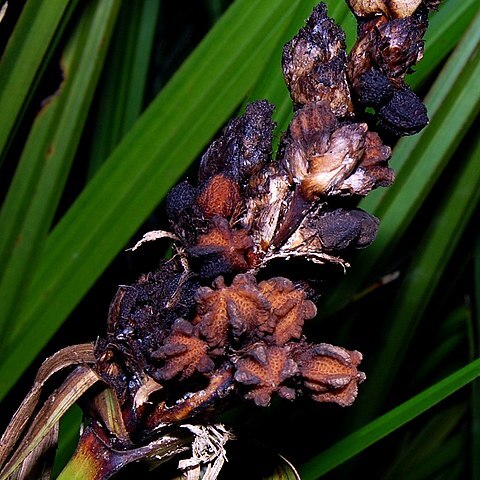Rhizome thick, forming large dense clumps, clothed with acute, imbricating scales and their fibrous remains. Stems smooth, 30-60 cm by 5-10 mm. Leaves numerous, coriaceous, drooping in the upper part, plicate, with 3 prominent nerves, aculeate-scabrous on the margins and the midrib beneath in the upper part, rather gradually narrowed into a filiform, triquetrous, scabrous, 15-25 cm long tail, 1-4 m by 2-5 cm; lower sheaths brown to dark castaneous. Panicle dense, oblong-ovoid, (5-)10-20 by up to 7 cm when in fruit; branches short, thick, obliquely spreading. Lower bracts (30-)60-150 cm long, the upper ones broadly ovate with filiform scabrous tip. Spikelets in sessile or almost sessile clusters, ovoid. Glumes ovate, obtuse, many-nerved, stramineous or greenish, c. 1 cm long. Flowers slightly shorter than the glumes. Anthers linear, 3-4 mm long. Fruit conical-ellipsoid, acute, usually with c. 6 more or less tuberculate longitudinal ribs, dusky brown, 1-1½ by c. 1 cm; ribs sometimes up to 10 and then often confluent at the top.
More
A herb or sedge. It keeps growing from year to year. It is coarse and has a woody rhizome. It grows 25-35 cm tall. The leaves are near the base and are like Pandanus leaves. These can be 100-230 cm long and 2-5 cm wide. They have teeth along the edge. The flower group are oval and 6-15 cm long by 3-5 cm wide. The fruit are 8-16 mm long and 6-11 mm wide. They are oval and angular and fleshy.
Freshwater tidal areas on clayish soil, tidal swamp forests, transition forests behind the mangrove, along river mouths, especially in places where during high tide or heavy rainfall the water is waist deep.
More
It is a tropical plant. It grows on the edges of marshes from sea level to 150 m altitude.
Uses. In Sumatra, Leyte, and the Moluccas (also in Ceylon) the dried leaves are used for making mats and hats, in Fiji for thatching. In S. Sumatra (Djambi, Palembang) the species is sometimes cultivated for this purpose. The material is apparently of inferior quality. In Samoa the fruits are eaten by the natives; this use is not reported from Malesia.
More
The succulent layer of the fruit is eaten.

